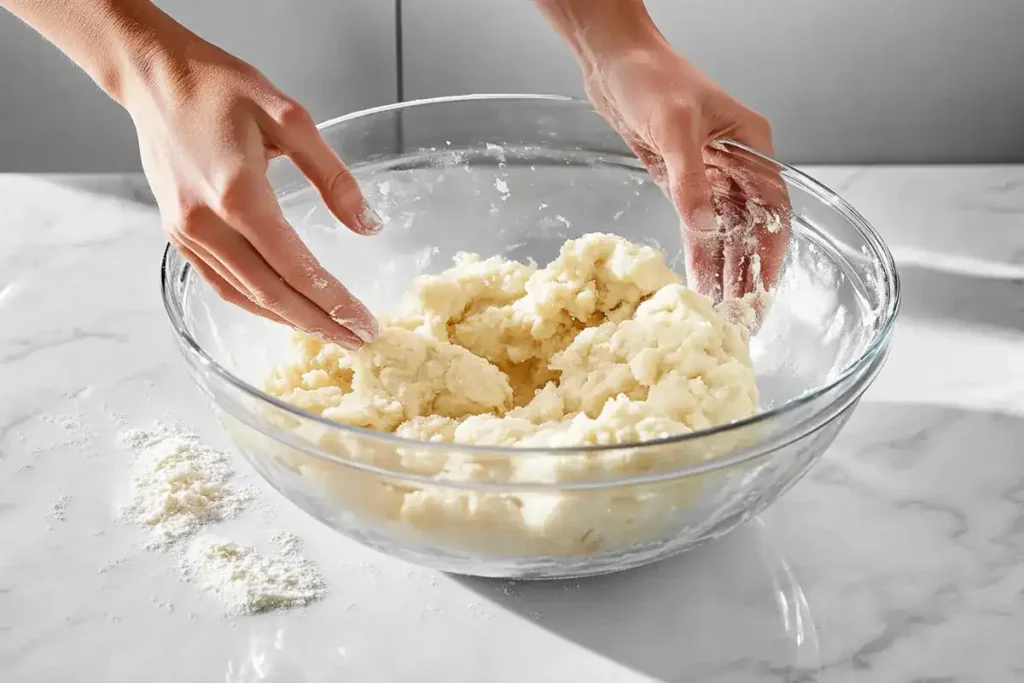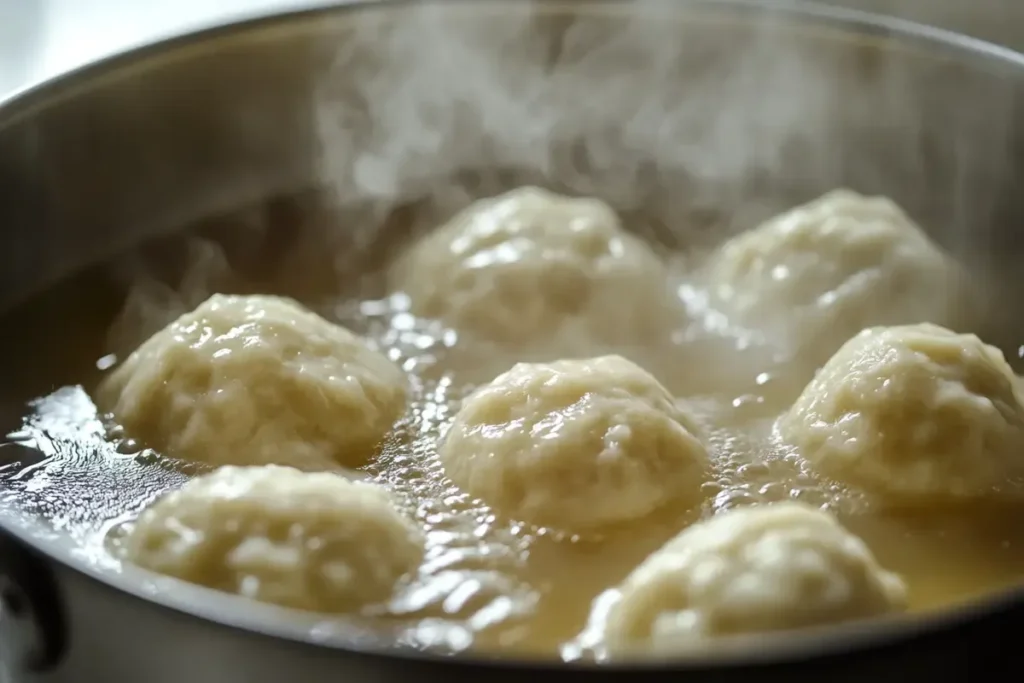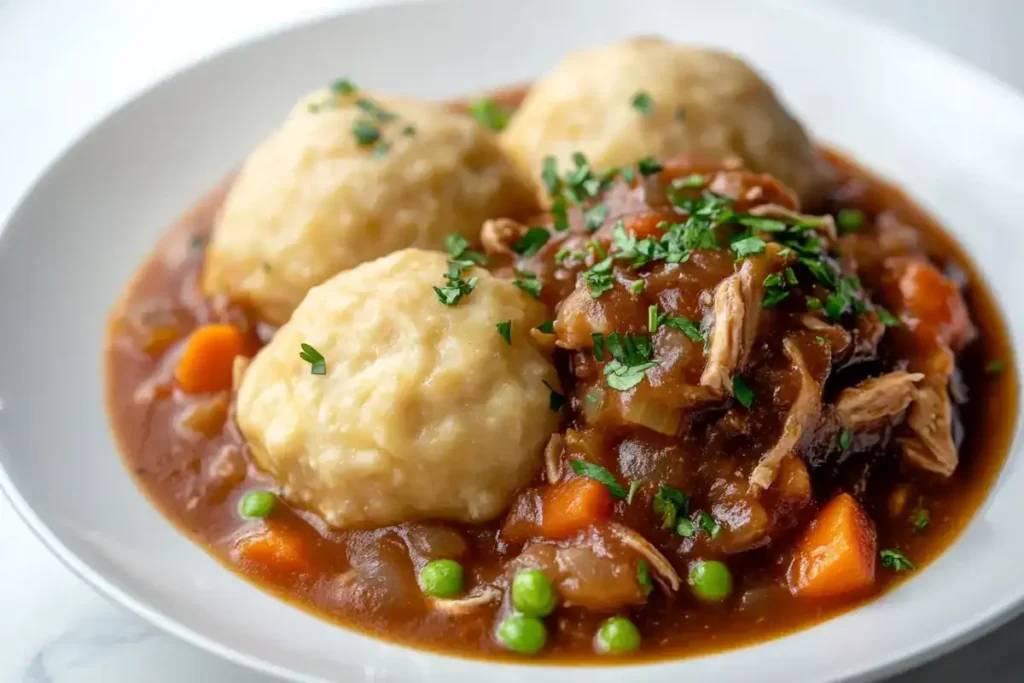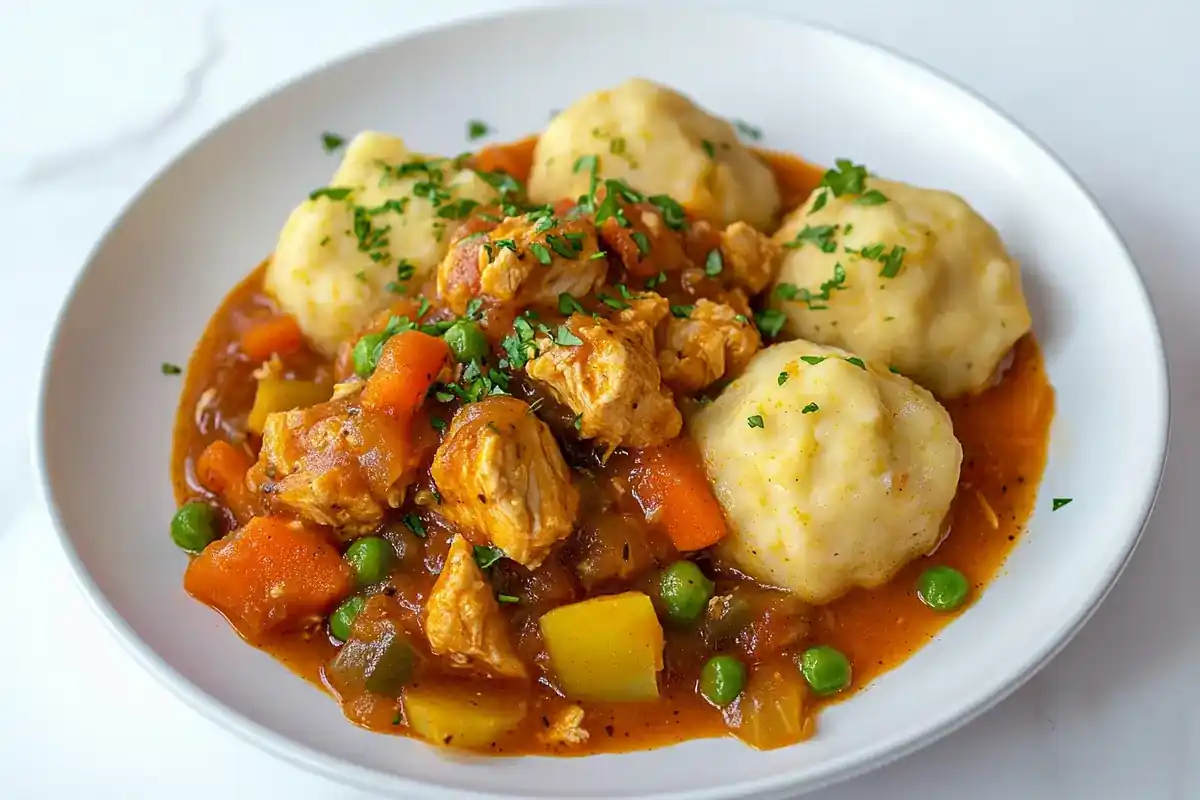introduction
When it comes to comfort food, few things beat a warm bowl of soup with fluffy, tender dumplings. But what happens when your Bisquick dumplings turn out dense and hard instead of soft and airy? If you’ve asked yourself, “Why are my Bisquick dumplings hard?”, you’re not alone. This common problem has simple fixes, and with the right techniques, you can achieve light, pillowy dumplings every time.
In this article, we’ll explore the most common reasons for hard Bisquick dumplings, uncover the science behind their texture, and provide step-by-step instructions for making the perfect dumplings. Whether you’re troubleshooting a tough batch or just starting your dumpling-making journey, this guide has you covered.
Common Reasons for Hard Bisquick Dumplings
The Role of Overmixing
One of the main culprits behind tough dumplings is overmixing the dough. When you stir too much, the gluten in the flour develops excessively, resulting in a dense, chewy texture. To avoid this, mix your batter just until the dry ingredients are combined with the wet. A few lumps are okay—they’ll smooth out as the dumplings cook.
Using a light hand while mixing is essential. For instance, use a spatula instead of a whisk to gently fold the ingredients together. This simple adjustment can make all the difference between hard dumplings and fluffy, tender ones.
Incorrect Liquid Ratio
Getting the liquid-to-mix ratio right is crucial. Too little liquid creates a dry batter that doesn’t steam properly, leading to tough dumplings. On the other hand, too much liquid makes the dough sticky and prone to overmixing, which can also result in dense dumplings.
For the perfect consistency, aim for a batter that’s slightly sticky but still holds its shape when dropped from a spoon. If the dough feels dry, add liquid a tablespoon at a time until it reaches the ideal texture. Conversely, if it’s too wet, sprinkle in a little more Bisquick mix and stir lightly.
By paying close attention to your mixing technique and batter consistency, you’ll be well on your way to solving the mystery of “Why are my Bisquick dumplings hard?”
Understanding the Science of Bisquick Dumplings
When pondering “Why are my Bisquick dumplings hard?”, it’s essential to understand the science behind their texture. A perfect dumpling strikes a balance between structure and fluffiness, achieved by mastering the gluten development and cooking method.
Gluten Development in Dough
Gluten is a protein found in flour that provides structure to baked goods. However, too much gluten can make your dumplings dense and hard. This overdevelopment happens when the dough is overmixed or handled too roughly.
To prevent this, mix your Bisquick batter lightly, just until all the ingredients are combined. Remember, lumps in the dough are not a problem—they’ll smooth out during cooking. Minimizing gluten formation ensures that your dumplings remain soft and tender.
Cooking Temperature and Timing
Another critical factor is the cooking process. Dumplings need gentle heat to cook evenly and retain their texture. Dropping dumplings into boiling liquid can cause the exterior to cook too quickly, leaving the center doughy. Overcooking them can also lead to tough, rubbery results.
For best results, maintain a simmer, not a boil, and follow the recommended cooking time in your recipe. Test one dumpling for doneness by cutting it open to ensure it’s cooked through but still moist and fluffy.
Understanding these principles will help you avoid tough dumplings and make every bite delicious.
Step-by-Step Recipe for Fluffy Bisquick Dumplings
Ready to master the art of making perfect dumplings? Here’s a foolproof recipe designed to eliminate the common pitfalls behind “Why are my Bisquick dumplings hard?”.
Ingredients
- 2 cups Bisquick mix
- 2/3 cup cold milk (adjust as needed)
- 1/4 teaspoon garlic powder (optional, for flavor)
- 1/2 teaspoon dried parsley (optional, for garnish)
Step-by-Step Instructions
1. Prepare the Dough
In a mixing bowl, combine Bisquick mix and optional seasonings. Add cold milk gradually, stirring gently with a spatula until the mixture forms a soft dough. Avoid overmixing to prevent tough dumplings.
2. Rest the Dough
Let the dough rest for 5–10 minutes. This step allows the flour to fully hydrate and ensures the dumplings will cook evenly without falling apart.
3. Drop the Dumplings
Using a spoon, drop spoonfuls of dough onto a pot of simmering soup or broth. Ensure the liquid isn’t boiling to prevent the dumplings from breaking apart. Leave space between each dumpling to allow for expansion.
4. Cook the Dumplings
Cover the pot with a lid and simmer for 10 minutes. Do not lift the lid during this time, as the trapped steam is essential for cooking the dumplings evenly. After 10 minutes, uncover the pot and cook for another 5 minutes.
5. Test and Serve
Check one dumpling by cutting it open; it should be cooked through and fluffy inside. Serve the dumplings immediately with your favorite soup or stew.
Nutritional Content (Per 100g)
| Nutrient | Value |
|---|---|
| Calories | 210 |
| Carbohydrates | 38g |
| Protein | 6g |
| Fat | 5g |
| Fiber | 2g |
| Sodium | 450mg |
For more Bisquick-based recipes, consider exploring this page on Bisquick dumplings. In the next section, we’ll tackle frequently asked questions to help you troubleshoot further.

FAQs About Bisquick Dumplings
When asking “Why are my Bisquick dumplings hard?”, it’s helpful to consider some common questions and their answers. Troubleshooting these issues will help you achieve light, fluffy dumplings every time.
Why Did My Dumplings Come Out Hard?
Hard dumplings often result from overmixing or incorrect liquid ratios. Stirring too much activates the gluten in the dough, leading to a dense texture. Using too little liquid can also make the dough dry and tough. To fix this, mix gently and stop as soon as the ingredients are just combined.
Adding the dumplings to boiling liquid can also toughen their texture. Instead, ensure the broth or soup is simmering gently when you drop the dumplings in. This reduces stress on the dough and promotes even cooking.
Why Are My Bisquick Dumplings Dense?
Dense dumplings can occur when the dough is too dry or compacted. Using cold milk or water and measuring ingredients accurately can help you avoid this problem. Another tip is to let the dough rest for a few minutes before cooking, as this gives the flour time to hydrate fully.
If you’re still having trouble, you might consider checking out our related bottom dumpling recipe for additional inspiration and tips.
How Do You Keep Dumplings Soft?
The key to soft dumplings lies in using the right cooking method. Always cook them in a covered pot to trap steam, which helps create a fluffy interior. Avoid lifting the lid too soon, as this can interfere with the steaming process.
Letting the dough rest for 5–10 minutes before cooking is another way to ensure soft, tender results. This simple step allows the ingredients to combine more evenly and reduces the risk of toughness.
What Is the Secret to Juicy Dumplings?
Achieving juicy dumplings is all about balance. The dough should be slightly sticky but firm enough to hold its shape. Dropping the dumplings into a well-simmered broth infuses them with moisture while preventing them from falling apart.
For an extra boost of flavor, consider adding herbs or seasonings to your batter. Ingredients like parsley or garlic powder can elevate your dumplings without altering their texture.

Pro Tips for Making Perfect Bisquick Dumplings
Mastering the art of Bisquick dumplings requires attention to detail. These pro tips will ensure your dumplings turn out light and delicious every time.
The Importance of Resting the Dough
Letting the dough rest before cooking is a game-changer. This short break allows the Bisquick mix to absorb the liquid fully, creating a dough that’s easier to work with and more consistent in texture. A rest period of 5–10 minutes is usually enough.
Resting also helps the dumplings cook more evenly. When you skip this step, the flour may not fully hydrate, leading to uneven cooking and dense spots.
Experimenting with Flavors and Add-Ins
Why settle for plain dumplings when you can infuse them with exciting flavors? Adding herbs, spices, or even cheese to your batter is an easy way to customize your recipe. Try incorporating ingredients like:
- Dried parsley or thyme for a savory twist.
- Garlic or onion powder for added depth.
- Shredded cheddar for a rich, cheesy flavor.
These simple additions can transform your dumplings into a standout side dish.
For more creative cooking ideas, explore our collection of recipes at PamPam Recipes. Whether you’re perfecting your dumplings or looking for new inspirations, there’s plenty to discover!

LSI and NLP Keywords for Better Optimization
When crafting content for questions like “Why are my Bisquick dumplings hard?”, using LSI (Latent Semantic Indexing) and NLP (Natural Language Processing) keywords improves SEO and ensures your article resonates with readers. These keywords align with what people are searching for, helping your content reach the right audience.
Related Keywords
Incorporating these keywords naturally into your content will make it more relevant and valuable:
- Bisquick dumpling troubleshooting
- Fluffy dumpling recipe
- How to fix dense dumplings
- Best liquid ratio for Bisquick dumplings
- Why are my dumplings chewy?
These terms highlight common concerns and solutions, ensuring your article covers everything readers need to know.
Synonyms for Key Phrases
Using synonyms for the focus keyword prevents repetition while keeping the content engaging. For instance:
- How to make soft dumplings
- Perfect Bisquick dumplings every time
- Troubleshooting tough dumplings
- Light and fluffy Bisquick dumpling recipe
By weaving these phrases into your article, you create a comprehensive resource that answers multiple related questions.
Common Mistakes to Avoid When Making Bisquick Dumplings
While mastering the perfect dumplings, it’s easy to make a few missteps. Recognizing these mistakes will save you from asking “Why are my Bisquick dumplings hard?” and help you achieve consistently fluffy results.
Overmixing the Dough
One of the most common errors is overmixing the batter. Stirring too much develops gluten, which creates a dense and tough texture. To prevent this, mix the ingredients just until they come together. The batter should still have some lumps—it’s a sign you haven’t overworked it!
If you’re using a whisk, switch to a spatula or wooden spoon for more gentle mixing. This small change can make a significant difference.
Cooking at the Wrong Temperature
Adding dumplings to liquid that’s boiling vigorously can cause them to cook unevenly, resulting in a tough exterior and raw center. On the flip side, if the liquid isn’t hot enough, the dumplings may fall apart. Always aim for a steady simmer and cover the pot with a lid to trap steam and cook the dumplings evenly.
Additional Tips for Perfect Bisquick Dumplings
Now that you know what to avoid, here are some extra tips to take your dumpling game to the next level. These small adjustments can make a huge difference in both flavor and texture.
Use Fresh Ingredients
Old Bisquick mix or stale milk can affect the texture of your dumplings, making them harder than expected. Always check the expiration date on your Bisquick and use fresh, cold milk or water for the best results.
Adjusting for High Altitudes
If you live at a higher altitude, the cooking process might require some tweaks. Dumplings can take longer to cook at higher elevations, so increase the cooking time slightly while keeping the liquid at a steady simmer.
Customize with Add-Ins
Want to elevate your dumplings? Try adding a touch of seasoning to the batter, like dried parsley, thyme, or a pinch of garlic powder. These simple additions enhance the flavor without affecting the fluffy texture.
For more inspiration and recipes, explore other comforting dishes on PamPam Recipes. With these tips and techniques, you’ll never have to wonder, “Why are my Bisquick dumplings hard?” again. You’re now equipped to make perfect dumplings every single time!
Conclusion
Achieving perfectly soft and fluffy dumplings isn’t as hard as it may seem. By addressing the key question, “Why are my Bisquick dumplings hard?”, this guide provides actionable tips and insights to help you troubleshoot common issues and avoid dense or chewy dumplings.
Final Tips for Perfect Dumplings
To recap:
- Mix gently to prevent overdeveloping gluten.
- Use the right liquid ratio for a soft, sticky dough.
- Let the dough rest to enhance texture and consistency.
- Simmer dumplings in covered pots for even cooking.
By following these steps, you’ll master the art of making Bisquick dumplings that are tender, delicious, and crowd-pleasing.
Explore More Recipes
For more culinary inspiration, check out other comforting recipes on our website, like this easy bottom dumpling recipe. Whether you’re looking to perfect your technique or try something new, there’s a recipe for everyone.
With a little practice and these tips, you’ll turn every batch of dumplings into a success. Happy cooking!

